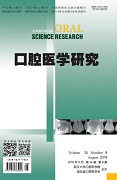|
|
Diversity and Community Structure of Subgingival Bacterial from Patients with Moderate or Severe Periodontitis
FAN Hua-nan, HUANG Hui, JIANG Qing-kun, LIU Yi
2018, 34(8):
846-851.
DOI: 10.13701/j.cnki.kqyxyj.2018.08.012
Objectve: To investigate and compare the oral microbial community from patients suffering severe and mild periodontitis by using high throughput sequencing of 16s rDNA genes. Methods: Seventy patients with moderate or severe periodontitis were selected as the subjects. According to their symptoms, they were divided into SP (severe periodontitis, 9 cases) group and MP (moderate periodontitis, 8 cases) group. The subgingival bacteria of the patients were sequenced with 16s rDNA. Then the OUT(operational taxonomic units)abundance of each sample and the classification of each level (domain, boundary, gate, class, order, family, genus, and species) were counted and analyzed with α and β diversity. Finally, the data of 16S rRNA for each sample were analyzed and the function of bacteria was predicted. Results: The high quality sequence (555028) obtained from subgingival samples (555028) was divided into OTUs, representing 303 independent species, belonging to 138 genera, 75 families, 47 orders, 28 classes and 12 phyla. Two groups shared 332 OTUs, indicating the presence of a core subgingival microbiome. α diversity analysis showed that the microbial diversity in severe periodontitis exceeded that of moderate periodontitis. The dominant phyla of subgingival microbiota included Bacteroidetes, Firmicutes, Fusobacteria, Proteobacteria, and Spirochaetae. The dominant genera included Fusobacterium, Streptococcus, Porphyromonas, Prevotella, Neisseria, and Treponema. β diversity analysis showed that the microbial community structure was similar in two groups. All the samples were predicted 39 kinds of metabolic function, mainly concentrated in the membrane transport (10.9%),replication and repair (9.9%), glucose metabolism (9.3%), amino acid metabolism (9.1%), translation (6.9%), energy metabolism (5.8%), and bad character (5.1%). Conclusion: The subgingival bacteria of periodontitis have rich diversity and stable community structure. The function of subgingival bacteria is the same as the bacteria in other parts of the mouth. The severity of periodontitis is related to the diversity of subgingival bacteria, but not related to the community structure of the bacteria. In view of the microbial diversity and symbiosis of periodontitis, the therapeutic strategies for regulating the interaction and function of microorganism should be further developed.
References |
Related Articles |
Metrics
|

